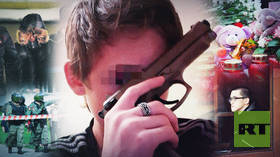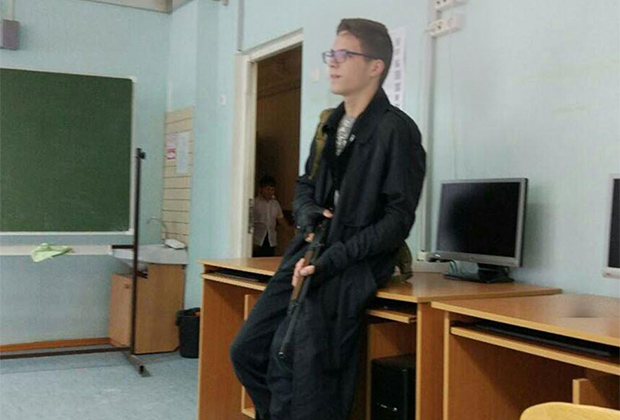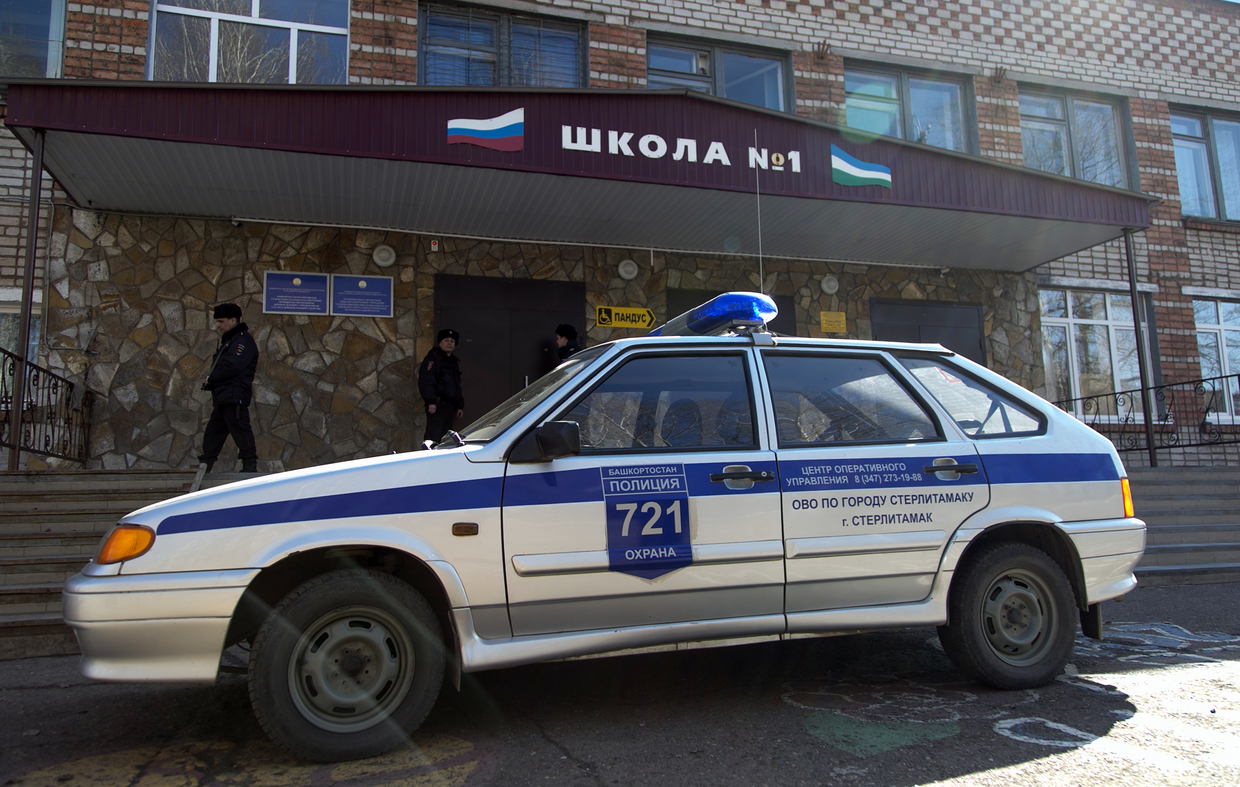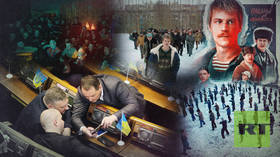‘I just wanted to die’: How US-style school shootings took hold in Russia and what Moscow is doing about it

Almost 25 years ago, on April 20, 1999, American students Eric Harris and Dylan Klebold attacked Columbine High School. They killed 15 people and injured 24 more. Their crimes have become a symbol of the type of violence that can be unleashed by disturbed teenagers who are discontent with life.
Somehow, the killers acquired followers, and their legacy is alive to this day. Because of this, Russia has recently banned any reference to Columbine and the shooters that could be interpreted in a positive light.
It was not “indiscriminate Russian censorship” that led to such a decision but a series of tragedies.
The Columbine effect
Eric Harris and Dylan Klebold have long become a part of popular American culture. The story of their crime is told in songs, movies, and even video games that recreate the shootings.
The Columbine massacre was neither the first nor the deadliest shooting in US history. For example, just 11 months before the Harris and Klebold attacks, a student – also dressed in a long leather coat and carrying a weapon – had attacked a school in Springfield.
However, it was the Columbine massacre that made the biggest impression on the American people. Surely, the killers themselves wanted to turn the shootings into a media event – they published a manifesto and made videotapes of their preparations for the attack. However, the media, which discussed the story for a long time, and the politicians who used it to promote their initiatives were also responsible for the attention given to the criminals.
In any case, the attack became so “popular” that it gave rise to the ‘Columbine effect.’ The shooting served as an example for copycat killers.
Journalistic investigations revealed that dozens of criminals tried to reenact the Columbine massacre over the past 20 years. Researchers believe that Harris and Klebold even created a “script” that other shooters follow. Some of the criminals claimed to have been directly inspired by the Colorado terrorists.
The Columbine effect has extended beyond the USA and reached other countries. For example, Brazilian teenagers who attacked their former school in 2019 were inspired by the Columbine massacre.
In Russia, Harris and Klebold also found followers.
Russian Columbine
Exactly ten years ago, the first school shooting in Russia’s modern history occurred. At noon on February 3, tenth grader Sergei Gordeev came to school No. 263 in Moscow’s Otradnoye district. He was dressed in a long black coat, under which he hid a Browning carbine and a Tikka rifle, which he got from his father’s safe.
Having overpowered the security guard, Gordeev headed for the room where his classmates were having a geography lesson. He shot the teacher in the head, then went to the teacher’s desk and told his classmates that the whole world is an illusion and that only he exists, and when he dies, the world will vanish.
When the police arrived at the school, they tried to detain Gordeev, but he resisted. A policeman was killed in the shootout. Gordeev surrendered only when persuaded to do so by his father, who arrived at the scene later.

The investigation revealed a strange and frightening detail – Gordeev was not a victim of bullying. He had a normal relationship with teachers and other students and was not bullied or incited to violence. His school life wasn’t different from that of other students.
It was not the idea of taking revenge on his abusers or society that drove him to commit murder, but only the desire to prove his solipsism theory – i.e. faith in the illusory nature of the world.
Five days after the shooting, Gordeev spoke to journalists. He didn’t want to talk about his preparations for the attack or his feelings after the arrest. But he explained his motivation.
“I didn’t want to kill anyone, I wanted to die. I was wondering what would happen after that. What is there after death? I also wanted to see how people would react to what I was doing. I came to kill myself. I had no conflicts with Andrey Nikolaevich [the slain geography teacher], on the contrary, we had good relations. When he came towards me, I shot him – I don’t even know why I did that, maybe because no one believed that I could shoot?”
Gordeev added that he was “ready to bear punishment.” The trial went on for a long time, and after a year and a half, Gordeev was declared insane and sent away for compulsory treatment. A criminal case was opened against his father for the negligent possession of firearms, but it was later suspended. A year later, his father was granted amnesty.
After this incident, educational institutions in Russia were inspected for compliance with security requirements, and new measures for controlling the circulation of weapons were discussed. However, this did not prevent new tragedies from happening in schools.
On September 5, 2017, ninth-grader Mikhail Pivnev from the city of Ivanteevka near Moscow came to his school with an air rifle and a hatchet and attacked a teacher and his classmates. He shouted that he had been planning the attack for three years and “came to die.”
The students managed to shut themselves in a classroom and hold out until the police arrived. Pivnev was detained without violence, and the wounded were rescued.

According to some, the student was bullied by his classmates for acting strange, wearing military-style outfits, and even coming to class with camouflage paint on his face.
Strangely enough, knowledge of the Columbine massacre could have prevented the tragedy. On social networks, Pivnev chose the username “Mike Klebold,” which directly pointed to his role model. However, the name of the killer from Colorado didn’t mean anything to the schoolboy’s acquaintances.
Also, before the attack, Pivnev posted: “Deleting my life on 05.09.17”
A year later, 17-year-old Artyom Tagirov came to school in the city of Sterlitamak in the Republic of Bashkortostan and attacked his classmates and a teacher with a stationery knife. He then poured gasoline on the floor and set it on fire. Tagirov also tried to commit suicide by slashing himself in the throat with a knife but was saved by doctors.
Tagirov’s story is typical for teenage shooters: He had a history of problematic behavior, studied in a “corrections class,” which is a special class for mentally or physically disabled children, and was bullied by other students.
But there is another disturbing detail: Artyom openly talked about his plans. He told friends about what he was going to do and mentioned his “source of inspiration.”
“I’ve already prepared everything. I’ll take people with me. I want to [hear] screams, see tears, fear... 18 [people] at least. I hate society. They’ll have to pay for it. You can consider me a follower of Eric and Dylan. I was bullied at school for two years. My hatred won’t just go away,” he wrote.
However, the threats were ignored until it was too late.

Despite the growing concern and stricter security standards, shootings and armed attacks have continued.
Over the past ten years, there have been 14 cases of armed attacks by teenagers in Russian schools. Almost half of the attacks resulted in deaths.
Fortunately, not all of the planned attacks have been carried out. Intelligence agencies and the police detain potential killers while they are still plotting the crimes. The last such attack was prevented by the Federal Security Service (FSB) a month ago. A teenager from the Moscow region was detained – he was exchanging messages with an unknown contact who gave him advice on storing weapons and planning an attack on a school.
Legacy
Russia has quickly drawn the necessary conclusions from such tragic events. In addition to strengthening security measures in schools, the state authorities, large companies, and individuals have come together to fight against the main cause of the shootings: bullying.
In recent years, this problem has received a lot of attention. Mentors and psychologists specializing in conflict prevention and analysis work in schools, tech corporations conduct large-scale anti-bullying campaigns, and the State Duma is discussing the implementation of a “school friendliness index” and a special app where students can report cases of abuse. Specialists are also learning to work more effectively.
Unfortunately, the problem was noticed later than it should have been. The Columbine effect has already spread far and wide.
In 2022, an investigation found almost 700 social media communities that were ideologically tied to Columbine. Surely, these groups are mostly made up of edgy teenagers who will outgrow their rebellious phase just like their parents and their parents’ parents did before them. But among them, there may be some who are indeed ready to carry out armed attacks.
Due to America’s strange obsession with the two killers and the desire to tell their story over and over again, the Columbine effect has affected many unstable and unhappy teenagers. So much so that 26 years later, in a country on the other side of the world, there are still people who want to reenact the crime of Harris and Klebold.














